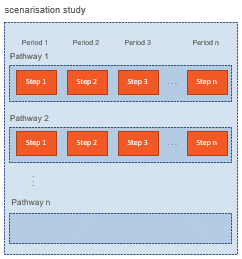Glossary#
Study#
A study gathers a set of power system configurations (so-called “contexts”, see below) and specific parameter and indicator configurations dedicated to the studied case
Context#
Term used to describe a modelled state of a given power system configuration. A context contains all the information required for simulation: portfolio parameters, physical and financial parameters, datasets, optimization parameters, etc. Several test cases can be included in a context, to represent different weather scenarios.
Test case#
A test case is a variability dimension, which can cover for example weather variations or outages for thermal groups. They usually impact demand, timeseries, renewable generation profiles, temperature-dependent parameters.
The dispatch varies for a test case to another, while the capacities remain unchanged. Results can be assessed across multiple testcases.
Asset#
An asset represents an entity modelled in a context, which may be a consumer, a producer, etc.
Node (or Delivery point)#
Each asset is connected to one or several nodes, where the supply and demand equilibrium is performed. Small islands can be represented by a single node while larger ones could be described at a higher granularity. Interconnectors allow for energy exchanges between nodes.
Behaviors#
For some assets, several models are available (some more simple, others more refined). Behaviors are a way to activate model refinements.

Attributes#
Attributes are the parameters that define an asset. The list of attributes depends on the type of the asset. Some attributes can be activated or deactivated by a given behavior.
Scenarisation study#
A scenarisation study is a specific type of study which contains one or multiple pathways instead of contexts. The pathway object represents a scenario and can be visualized as a diagram. It is composed of connected pathway steps.
Pathway#
A pathway represents a possible evolution of the energy system. It starts with a representation of the system at a given time, and continues with a set of representative years for the future.
Period#
A period represents a time point in the scenarisation study horizon. For instance, the user may split the horizon between 2020 and 2050 into 4 periods: 2020, 2030, 2040, 2050. Periods must be equally spaced in time.
Pathway step#
A pathway is constituted of multiple milestones called pathway steps. Each step represents a situation of an energy system for a given period. A context is associated to the pathway step to represent this state of the energy system.

